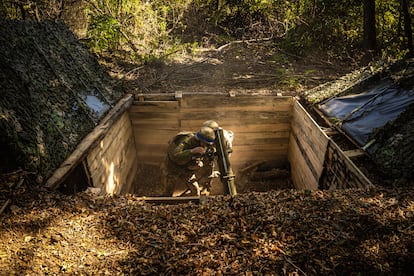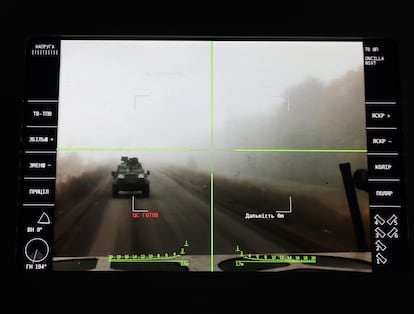Ukraine deploys its best units to stage long-term resistance on Russian soil
Kyiv is determined to maintain its occupation of Kursk province while Moscow’s forces are advancing relentlessly on the Donetsk front and threatening a new offensive in the south

The artillery fire, air raids and movement of armored vehicles are so intense in Sumy that it is a stark contrast compared to Ukraine’s weak position in the hottest spots in Donbas. Sumy province is the rearguard of the three-month-old operation that has allowed Kyiv’s forces to occupy part of Russia’s Kursk region. The soldiers interviewed in late October in the area say that if there is anything they need, it is more weapons. The number of troops deployed is clearly greater than that of their brigades retreating south of Donetsk.
Nobody in Kursk is complaining about the lack of personnel: rotations in the State Border Guard platoon commanded by Vadim take place every 10 days. At first it was every three days, says this veteran soldier, who prefers not to reveal his last name. But in places in Donbas besieged by Russian forces, such as Kurakhove, the average time that infantry units must spend on the front line is 25 days, according to four brigades consulted by this newspaper this October.
The invasion of Kursk is a personal gamble for Ukrainian President Volodymyr Zelenskiy, and on the success of the operation depends not only his political fate, but that of the country. Demonstrating to Russia that it is vulnerable and that its territory can also be threatened is one of the five points of Zelenskiy’s plan for victory, a document that he has presented to his international allies to improve Ukraine’s situation in the war and to arrive at potential future peace negotiations in a position of greater strength.
The obstacles to Zelenskiy’s objectives are enormous, even more so after Donald Trump’s victory in the U.S. presidential elections. The president-elect insisted during his campaign that his priority is to turn off the tap to Kyiv in terms of military assistance and to seal an agreement between Zelenskiy and Vladimir Putin as soon as possible, even if it means Ukraine ceding territory to Moscow. In addition, Russian forces are preparing a new offensive on the southern front in Zaporizhzhia.
North Korean presence
Russia has regained a third of the territory it lost in Kursk province, but this is modest progress compared to its current advance in Donetsk. The gray zone in Kursk, which neither side controls, is especially wide and the Ukrainian troops continues to hold the offensive initiative. The Institute for the Study of War reported last Friday that Ukrainian forces had advanced on the village of Novoivanovka. This is also demonstrated in videos released by its military units in which tanks and infantry vehicles are seen assaulting Russian positions on the front line. Such actions are unthinkable on the various open fronts inside Ukraine.
According to estimates by the Ukrainian General Staff, Russia has allocated 45,000 soldiers to the counteroffensive to regain control of Kursk. The military officials surveyed estimate that half of them are recent recruits, meaning they have no combat experience. The Kremlin does not want to slow its advance in Donetsk and has opted for its alliance with North Korea to strengthen the defense of Kursk, without weakening its position in other theaters of the war. NATO, the United States, South Korea, and Ukraine have indicated that some 11,000 North Korean soldiers will take part in the fighting in Kursk. Zelenskiy stated on November 5 that the first clashes between Ukrainian troops and Pyongyang’s forces have already taken place. Several military analysts stated in Forbes and The New York Times that North Korean troops are fighting at the forefront of the offensive to liberate Kursk alongside the 810th Russian Naval Infantry Brigade.
For the Ukrainian president, the North Korean alliance is proof that Russia lacks the men and equipment to continue to fight this war of attrition. “The goal is to continue advancing, because the front is fluctuating and we can break it, we can be in it for the long haul,” says Yaroslav, a sergeant with the Ukrainian 225th Separate Assault Battalion. The mission in Kursk, Yaroslav reiterates, “is to show that Russia is weak and cannot protect its own territory.” American military sources explained to Bloomberg on October 9 that the deployment allocated by the Armed Forces of Ukraine to Kursk will allow troops to stay there “for a few more months, or even longer.”

Mechanized and armored regiments such as the 1st Brigade have their best tanks — German Leopards — opening fire just a few hundred meters from the enemy. The 47th Mechanized Brigade, made up entirely of NATO weapons and training, has also shared videos of its American Abrams tanks and Bradley armored infantry vehicles directly attacking Russian positions. By contrast, in another sector of the front where the 1st Brigade operates, in Zaporizhzhia, its tanks only carry out quick defensive maneuvers, mainly being used as artillery far from the enemy lines.
Yevgeny is the commander of an assault company. He speaks to EL PAÍS while he and his unit prepare the machine guns on two Oncillas, a Polish-Ukrainian-made vehicle for attacks and infantry transport. Yevgeny explains that the incursion into Kursk was a surprise and the Russian forces had neither extensively mined the terrain nor built fortifications, as they have done in the occupied territories in Ukraine, so operations with their Oncillas are easier: “Here we can attack the Russian defenses with two tanks, opening fire, and then we go into action.”
One problem for his men, Yevgeny explains, is that some of the ammunition they have is faulty. One in ten rounds jams the machine gun and forces his team to retreat. Another drawback, he says, is that for a battalion of 340 soldiers carrying out offensive operations, they only have six Oncillas — each one can transport a dozen troops. Zelenskiy said on October 30 that Ukraine has only received 10% of the U.S. military aid, valued at around $60 billion, approved last April by Congress.
Air and communications superiority
According to Ukrainian military officials, Russian forces have two significant advantages. First, there is their superiority in the air. The impact of guided missiles fired by Russian bombers are constant in Sumy and Kursk. “The Russians are focusing their air strikes on our logistics network. In August, to reach the positions where we are fighting, we had to travel 15 kilometers, then it was 30, and now it is 45,” explains Technik, the code name of a soldier in the 95th Airborne Brigade.
The other advantage the Russians hold is telecommunications. The soldiers interviewed confirmed that they cannot use their cell phones because there is no coverage and they communicate mainly with walkie-talkies. Another serious setback for Ukraine is that its troops cannot use the Starlink satellite connection on Russian soil, which is not activated to provide a signal on Russian territory. Despite this, Oleg Apostol, commander of the 95th Brigade, and Pavlo Rozlach, commander of the 80th Airborne Brigade, assured in interviews with the media outlet Novy Narnia in October that they have found alternatives. Apostol, without specifying how, said that they had found a way to use Starlink; Rozlach acknowledged that they cannot use it, but that they are using other systems.
The 95th and 80th Brigades are two of the best regiments in the Armed Forces of Ukraine. They are examples of what Ukrainian General Dmitry Marchenko criticized in an interview on a YouTube channel on October 27: “Maybe our leaders have some kind of secret plan, otherwise I don’t understand why our best brigades are in Kursk, while our defenses in Ukraine are collapsing.” Marchenko’s voice is not the only one suggesting the operation on Russian soil is a mistake while the invader is gaining ground in Donetsk province every day. Politico reported in September that former army commander-in-chief Valerii Zaluzhnyi was also against the Kursk incursion. The commander of the Azov Brigade, Bogdan Krotevich, has also voiced criticism in the same vein.
Sign up for our weekly newsletter to get more English-language news coverage from EL PAÍS USA Edition
Tu suscripción se está usando en otro dispositivo
¿Quieres añadir otro usuario a tu suscripción?
Si continúas leyendo en este dispositivo, no se podrá leer en el otro.
FlechaTu suscripción se está usando en otro dispositivo y solo puedes acceder a EL PAÍS desde un dispositivo a la vez.
Si quieres compartir tu cuenta, cambia tu suscripción a la modalidad Premium, así podrás añadir otro usuario. Cada uno accederá con su propia cuenta de email, lo que os permitirá personalizar vuestra experiencia en EL PAÍS.
¿Tienes una suscripción de empresa? Accede aquí para contratar más cuentas.
En el caso de no saber quién está usando tu cuenta, te recomendamos cambiar tu contraseña aquí.
Si decides continuar compartiendo tu cuenta, este mensaje se mostrará en tu dispositivo y en el de la otra persona que está usando tu cuenta de forma indefinida, afectando a tu experiencia de lectura. Puedes consultar aquí los términos y condiciones de la suscripción digital.
More information
Archived In
Últimas noticias
Most viewed
- Sinaloa Cartel war is taking its toll on Los Chapitos
- Oona Chaplin: ‘I told James Cameron that I was living in a treehouse and starting a permaculture project with a friend’
- Reinhard Genzel, Nobel laureate in physics: ‘One-minute videos will never give you the truth’
- Why the price of coffee has skyrocketed: from Brazilian plantations to specialty coffee houses
- Silver prices are going crazy: This is what’s fueling the rally











































